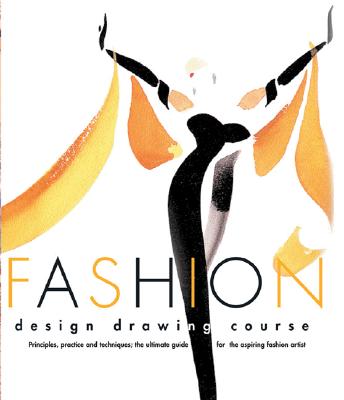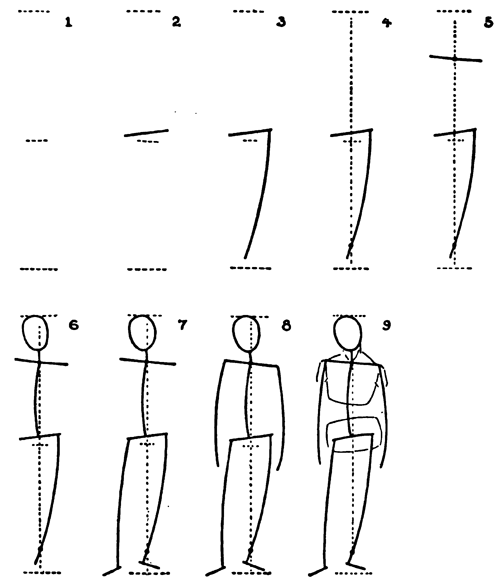Books: Fashion Design Drawing Course
By Carrie, Contributing Blogger:
I love to sew, and I love learning about sewing. Few things make me happier. Still, I’ve never had many aspirations toward design. I don’t plan to enter the fashion industry in any sort of professional capacity, and I’m generally content to borrow from someone else’s art, to have a set of instructions and perhaps add my own twists along the way.
This little book, though, made me wonder if I’ve just been too daunted to give designing a shot. Fashion Design Drawing Course is set up like a textbook, with individual units and project assignments. But you certainly don’t need the structure of an actual course in order to use and benefit from it; the authors make every step of design extremely accessible.
I should add that “accessible” doesn’t mean “dumbed down.” Rather, each lesson is clearly delineated, and even concepts as elusive as idea generation emerge as creative processes, not simply flashes of genius that are reserved for only a few of us.
I was immediately drawn to Chapter 1, Unit 2, where Tatham and Seaman suggest using architecture as inspiration. They remind us that buildings and garments are both three-dimensional art forms that engage space and surface in a profound way. I thought of Valparaiso, Chile, and as I paged through the rest of the book I had a secret Valparaiso Collection floating through the back of my mind. It was almost a guilty pleasure, because it’s something I truly never believed possible before… me? with a collection?
Maybe. Not to sell or display, but simply to try, to learn. And I’d keep this book with me every step of the way.
I especially liked the sections on figure drawing. While I always loved drawing as a kid and scribbled more pictures of horses than I knew what to do with, a sense of proportion always escaped me. The good news is you don’t really need a sense of it. You can use tricks such as paper folding and measuring the body according to “heads” to create a correctly proportioned fashion figure, even if you’re convinced you can’t draw.
Such steps and tricks may seem to steal a little of the magic, but Seaman and Tatham constantly encourage students to be bold, to use things like the figure as starting platforms. Although this book is extremely useful and practical, it never denies fashion design its status as a dynamic art.
Lest I get too carried away singing praises, I will say this: I was at first a little put off by the page lay-outs. They are very busy, with many images and asides. It’s hard to know what to look at first and hard to progress easily through the book.
I think, though, that this ends up being a very positive aspect and a smart choice on the part of the authors. As with all great books in any genre, Fashion Design Drawing Course will teach you how to read it. The primary lesson is that you won’t read it, but you’ll use it. You’ll want to linger on each unit, taking in the concise and smart summaries before you try the exercises for yourself, create a project, and move on to the guided self-critiques.
It may sound excessive and/or impossible, but I do believe that this book would be an asset to anyone’s sewing library, regardless of your level of expertise. It may not have the level of technical guidance needed by intermediate to advanced designers, but even they should find some new ideas and inspiration. I think it’ll be particularly useful for someone who’s always wanted to try his/her hand at design but never had the resources or, like me, never quite had the guts! This thin little book manages to give you both.
Image: Simple figures from Drawing How to Draw.

 Sign In
Sign In




Comments
StitchesByJeni
October 5, 2010 #
It is amazing how many things can bring on inspiration. I love the idea of a city springing to live as a fashion line.
Mary Beth at ✄ Fabric U ✄
October 5, 2010 #
The figure standing with the tilted posture just makes think of my own spine and how I need to go to the chiropractor. Of course, I do believe in drawing, I used to do lots of it. I need to do more. Copyright everything you do! You never know what will make you a millionaire.
Reader
October 5, 2010 #
I took an evening fashion sketching seminar at a well-known fashion design school. It used live models. It was open to all levels, but I can’t draw at all and it was far too advanced for me, for example, there was someone who worked for J.Crew. I guess he just wanted to brush up on some skills. His sketches were beautiful.
I asked the teacher to recommend a book. He suggested “Drawing Fashion” by Bill Thames. I asked him about another book I’d seen many fashion design students with, “9 Heads: A Guide to Drawing Fashion” by Nancy Riegelman or Reigelman. He said that was a good book, but too advanced for me right now.
Books by Steven Stipelman also have been recommended to me.
Reader
October 5, 2010 #
While interested in learning some fashion sketching, at the moment, I’m more focused on developing some croquis of myself in order to have a more realistic idea of how a garment would look on me.
Pashmina
October 23, 2010 #
Read your post made me remember how I always loved to draw as a child. I would spend hours doodling away, engaged in an act of creation. Funny how over time that urge disappears…. I guess some time I realized that I was never going to become Picasso…. or maybe creation wasn’t considered a “serious” subject at school.